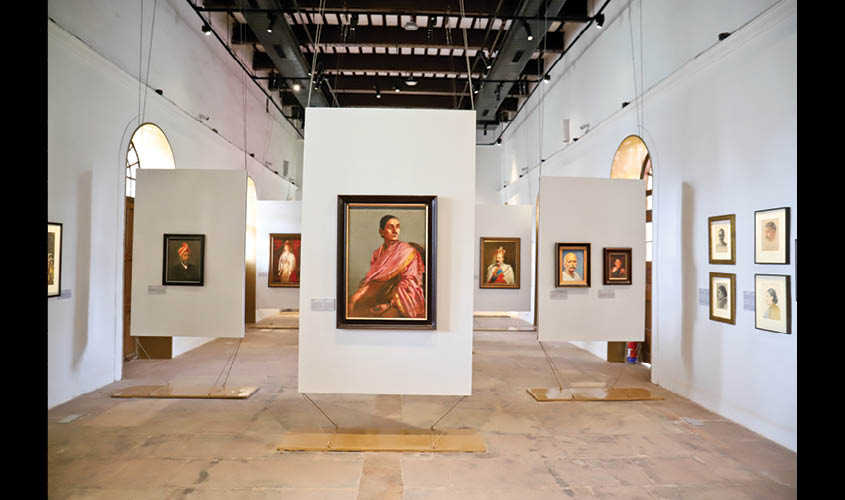Five British-era Army barracks at Delhi’s Red Fort have been converted into museums. The barrack museums have been filled with artworks and archival records related to the Indian Independence movement. Bhumika Popli reports.
The many barracks of Red Fort have, at separate points in history, have housed both British and Indian Army personnel. Now, five of these barrack halls have been turned into museums featuring artworks that touch upon various facets of the Independence struggle.
While one barrack is yet to open for the public, the other four are fully operational and they are rich repositories for anyone looking to get a crash course in the history of Indian Independence. Three of these museums are curated by the Archeological Survey of India (ASI) and one by Delhi Art Gallery.
The barracks, each of them measuring around 30,000 square feet, were constructed some 100 years ago by the Britishers on the Red Fort premises (the fort itself was built in 1639 by Shah Jahan). To reach the barracks, one has to cross Chhata Bazaar—a small flea market—and Noubhat Khana—“a place which welcomed the arrival of the emperor and his dignitaries with the sound of drums,” according to Avinash Kumar, a guard at Red Fort.
The barracks are triple-storeyed colonial style buildings made with red and white stones. A significant part of Red Fort was demolished in order to make room for these barracks. “These barracks, made by the Britishers after the vengeance of the 1857 Revolt, destroyed all the architectural ambience of Red Fort,” says Professor Kapil Kumar, chief historian of the museums.

According to Kumar, it was decided to convert these barracks into museums rather than demolish them, because of their gigantic size. He says, “Besides the size, we also wanted to show the Indian struggle for Independence to visitors from a site of national pride which is Delhi’s Red Fort.”
Visitors can get a comprehensive view of the Indian struggle for independence through the four museums. 1857 (which is in B1, or barrack number one) brings to light the struggles of the Mutiny; Yaad-e-Jallian (B2) reminds us of the massacre which took place at the Jallianwalla Bagh on 13 April 1919; INA and Netaji Subhash Chandra Bose (B3) introduces us to the life of Subhash Chandra Bose; and Azadi ke Diwane (B5), which will be ready in approximately a week’s time, will display exhibits related to the life of significant but lesser-known figures who made their mark in Indian history.
There are many narratives housed inside these barracks-turned-museums. A range of multimedia exhibits are on display: archival prints, audio recordings, illustrations and installation pieces.
Special attention has been given to the role of the common man in the national movement for Independence. “In B1, there is a narrative on the grass-cutters of Bihar who had stopped supplying grass to the British cavalry. In B3, we have displayed a copy of the fake news which was reported in 1942 in the New York Times which mentioned that Netaji has died in a plane crash. Another crucial aspect included here is a full panel which mentions 27 people who were shot in different prisons of the country much before the Indian National Army trial started in 1945 at the Red Fort,” says Kapil Kumar.
The exhibits at B5 museum will introduce viewers to many unknown aspects of the Indian freedom movement. “It will showcase the life of people imprisoned in the Andamans for supporting the movement and the revolutionaries abroad. There are also many separate sections for the women, children, tribals, farmers, who were either imprisoned or were martyred. The idea was to bring forward the oppressive practices used by Britishers such as massacres, firing, lathi charge and so on.”

While four of the barracks here contain the vast memorabilia of the Independence struggle, museum B4, run by DAG, houses a variety of paintings and prints, including architectural drawings commissioned by the Britishers in the 18th century. We also see here a number of prints that led to a whole new paradigm of commercial art in the early 20th century and further gave rise to “bazaar art”. One section, entitled A Portrait of our People, features many paintings in diverse mediums. These artworks transport us to the past where we become witness to the overall living style of people who belonged to another era. We also see paintings by distinguished Indian artists, such as Raja Ravi Varma, Rabindranath Tagore, Amrita Sher-Gil and Nandalal Bose among others.
Ashish Anand, MD, DAG says, “The motivation for Drishyakala at Barrack Number 4 of Red Fort comes from DAG’s core aim of democratising Indian art, that is, taking Indian art to a wider audience. We found that Red Fort, due to its historical significance, is a great venue to showcase 300 years of Indian art.”
The gallery has also initiated a number of art-related activities with children, college students, and the visually-impaired. “A selection of artworks from the main exhibition is converted into tactile reproductions. In this we were ably aided by the Raised Lines Foundation, which has been incubated at IIT Delhi. Each of these reproductions carries Braille captions in both Hindi and English,” says Anand.

